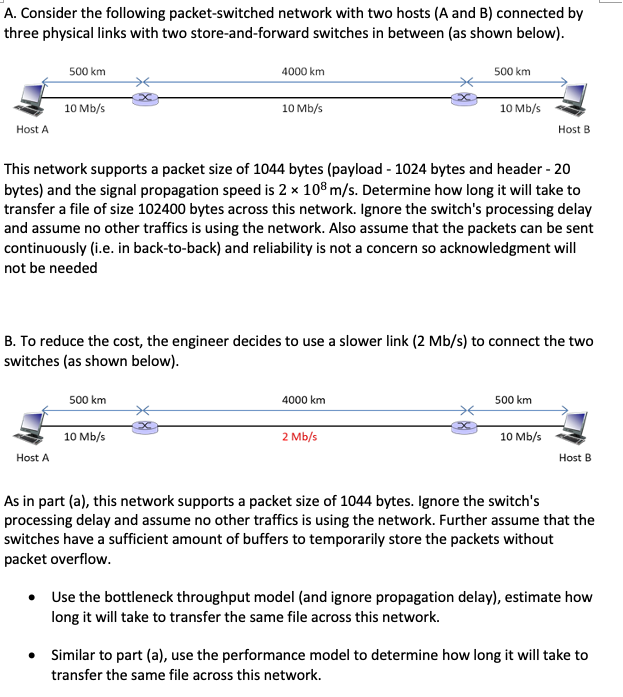A. Consider the following packet-switched network with two hosts (A and B) connected by three physical links with two store-and-forward switches in between (as shown below). Host A 500 km 10 Mb/s Host A 4000 km 500 km 10 Mb/s 10 Mb/s This network supports a packet size of 1044 bytes (payload-1024 bytes and header - 20 bytes) and the signal propagation speed is 2 x 108 m/s. Determine how long it will take to transfer a file of size 102400 bytes across this network. Ignore the switch's processing delay and assume no other traffics is using the network. Also assume that the packets can be sent continuously (i.e. in back-to-back) and reliability is not a concern so acknowledgment will not be needed B. To reduce the cost, the engineer decides to use a slower link (2 Mb/s) to connect the two switches (as shown below). 500 km 4000 km 10 Mb/s 2 Mb/s Host B 500 km 10 Mb/s Host B As in part (a), this network supports a packet size of 1044 bytes. Ignore the switch's processing delay and assume no other traffics is using the network. Further assume that the switches have a sufficient amount of buffers to temporarily store the packets without packet overflow. • Use the bottleneck throughput model (and ignore propagation delay), estimate how long it will take to transfer the same file across this network. • Similar to part (a), use the performance model to determine how long it will take to transfer the same file across this network.
A. Consider the following packet-switched network with two hosts (A and B) connected by three physical links with two store-and-forward switches in between (as shown below). Host A 500 km 10 Mb/s Host A 4000 km 500 km 10 Mb/s 10 Mb/s This network supports a packet size of 1044 bytes (payload-1024 bytes and header - 20 bytes) and the signal propagation speed is 2 x 108 m/s. Determine how long it will take to transfer a file of size 102400 bytes across this network. Ignore the switch's processing delay and assume no other traffics is using the network. Also assume that the packets can be sent continuously (i.e. in back-to-back) and reliability is not a concern so acknowledgment will not be needed B. To reduce the cost, the engineer decides to use a slower link (2 Mb/s) to connect the two switches (as shown below). 500 km 4000 km 10 Mb/s 2 Mb/s Host B 500 km 10 Mb/s Host B As in part (a), this network supports a packet size of 1044 bytes. Ignore the switch's processing delay and assume no other traffics is using the network. Further assume that the switches have a sufficient amount of buffers to temporarily store the packets without packet overflow. • Use the bottleneck throughput model (and ignore propagation delay), estimate how long it will take to transfer the same file across this network. • Similar to part (a), use the performance model to determine how long it will take to transfer the same file across this network.
Operations Research : Applications and Algorithms
4th Edition
ISBN:9780534380588
Author:Wayne L. Winston
Publisher:Wayne L. Winston
Chapter20: Queuing Theory
Section20.10: Exponential Queues In Series And Open Queuing Networks
Problem 8P
Related questions
Question
Solve this correctly

Transcribed Image Text:A. Consider the following packet-switched network with two hosts (A and B) connected by
three physical links with two store-and-forward switches in between (as shown below).
Host A
500 km
10 Mb/s
Host A
4000 km
500 km
10 Mb/s
10 Mb/s
This network supports a packet size of 1044 bytes (payload-1024 bytes and header - 20
bytes) and the signal propagation speed is 2 x 108 m/s. Determine how long it will take to
transfer a file of size 102400 bytes across this network. Ignore the switch's processing delay
and assume no other traffics is using the network. Also assume that the packets can be sent
continuously (i.e. in back-to-back) and reliability is not a concern so acknowledgment will
not be needed
B. To reduce the cost, the engineer decides to use a slower link (2 Mb/s) to connect the two
switches (as shown below).
500 km
4000 km
10 Mb/s
2 Mb/s
Host B
500 km
10 Mb/s
Host B
As in part (a), this network supports a packet size of 1044 bytes. Ignore the switch's
processing delay and assume no other traffics is using the network. Further assume that the
switches have a sufficient amount of buffers to temporarily store the packets without
packet overflow.
Use the bottleneck throughput model (and ignore propagation delay), estimate how
long it will take to transfer the same file across this network.
Similar to part (a), use the performance model to determine how long it will take to
transfer the same file across this network.
Expert Solution
This question has been solved!
Explore an expertly crafted, step-by-step solution for a thorough understanding of key concepts.
Step by step
Solved in 2 steps with 2 images

Knowledge Booster
Learn more about
Need a deep-dive on the concept behind this application? Look no further. Learn more about this topic, computer-science and related others by exploring similar questions and additional content below.Recommended textbooks for you

Operations Research : Applications and Algorithms
Computer Science
ISBN:
9780534380588
Author:
Wayne L. Winston
Publisher:
Brooks Cole

Comptia A+ Core 1 Exam: Guide To Computing Infras…
Computer Science
ISBN:
9780357108376
Author:
Jean Andrews, Joy Dark, Jill West
Publisher:
Cengage Learning

A+ Guide To It Technical Support
Computer Science
ISBN:
9780357108291
Author:
ANDREWS, Jean.
Publisher:
Cengage,

Operations Research : Applications and Algorithms
Computer Science
ISBN:
9780534380588
Author:
Wayne L. Winston
Publisher:
Brooks Cole

Comptia A+ Core 1 Exam: Guide To Computing Infras…
Computer Science
ISBN:
9780357108376
Author:
Jean Andrews, Joy Dark, Jill West
Publisher:
Cengage Learning

A+ Guide To It Technical Support
Computer Science
ISBN:
9780357108291
Author:
ANDREWS, Jean.
Publisher:
Cengage,

Principles of Information Systems (MindTap Course…
Computer Science
ISBN:
9781285867168
Author:
Ralph Stair, George Reynolds
Publisher:
Cengage Learning

Principles of Information Security (MindTap Cours…
Computer Science
ISBN:
9781337102063
Author:
Michael E. Whitman, Herbert J. Mattord
Publisher:
Cengage Learning

Systems Architecture
Computer Science
ISBN:
9781305080195
Author:
Stephen D. Burd
Publisher:
Cengage Learning